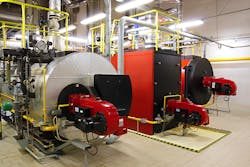Previous articles described the existing installation and operation of a fume flowmeter for an incinerator. The new installation was more complex and used fumes to replace up to 80 percent of the combustion air but could drop to near zero flow in approximately 5 seconds. The new fume flowmeter measurement was used in the combustion control strategy and also in the control strategy to ensure that the fume nozzles did not overheat.
Examination of the new thermal flowmeter revealed encrustation on the thermal sensor. Discussion with the manufacturer indicated that the encrustation was likely caused by small droplets in the fume that hit the heater and were subsequently evaporated by the heater, leaving behind a residue that caused the flowmeter to function improperly. Although the new insertion Pitot tube flowmeter functioned reliably for years, the plant would have preferred to have had the superior measurement available from the insertion thermal flowmeter.
Recent discussions with a thermal flowmeter manufacturer brought to light another potential cause of the encrustation. In humid flowing streams, the outside temperature is often lower than the gas temperature, so liquid tends to condense on the pipe wall. When the thermal probe is mounted on the top of the pipe, any condensate formed at the top of the pipe and its tap can travel down the probe to the sensor, where it can adversely affect the measurement.
For humid gas service, thermal flowmeter manufacturers suggest that insertion thermal probes be oriented such that condensation on the pipe walls cannot travel down the probe to the sensor. This can be achieved by installing the probe pointing upward from the bottom of the pipe or upward at up to a 45-degree angle from the bottom of the pipe so condensation on the probe will flow away from the sensor.
After almost three decades, I now question whether this detail was the difference between success and failure.



